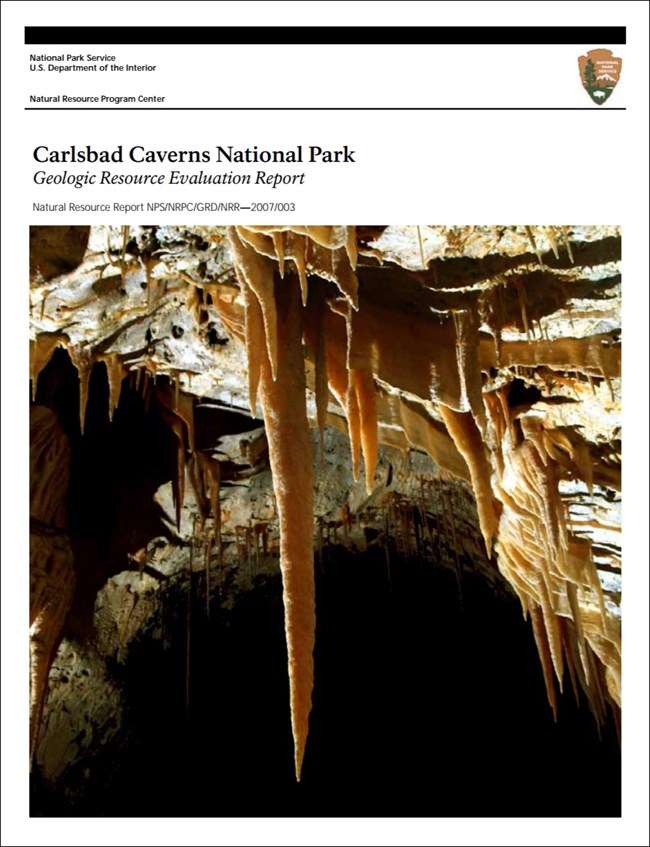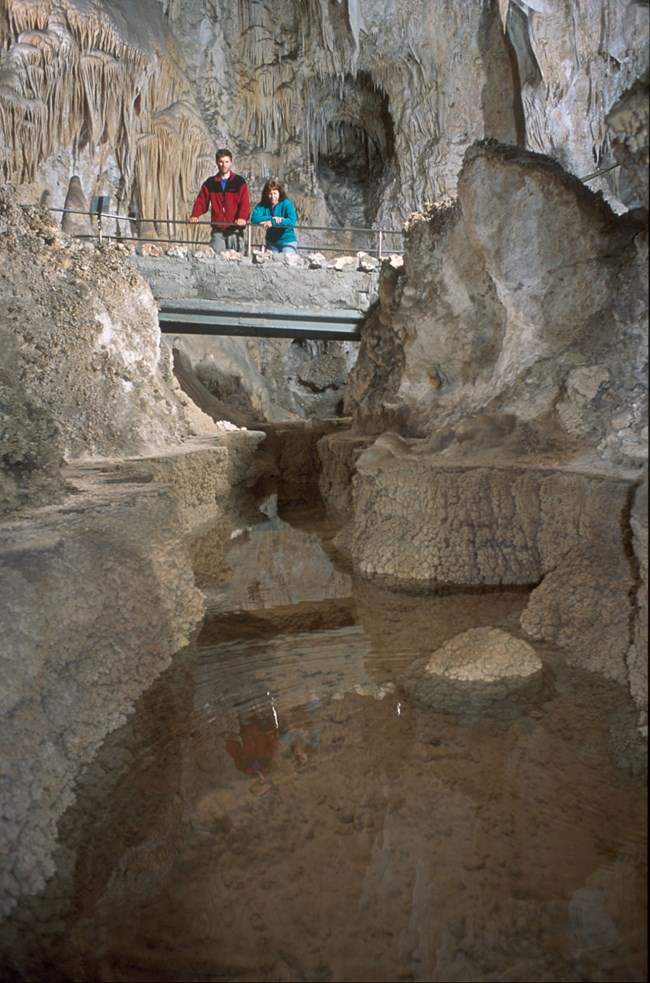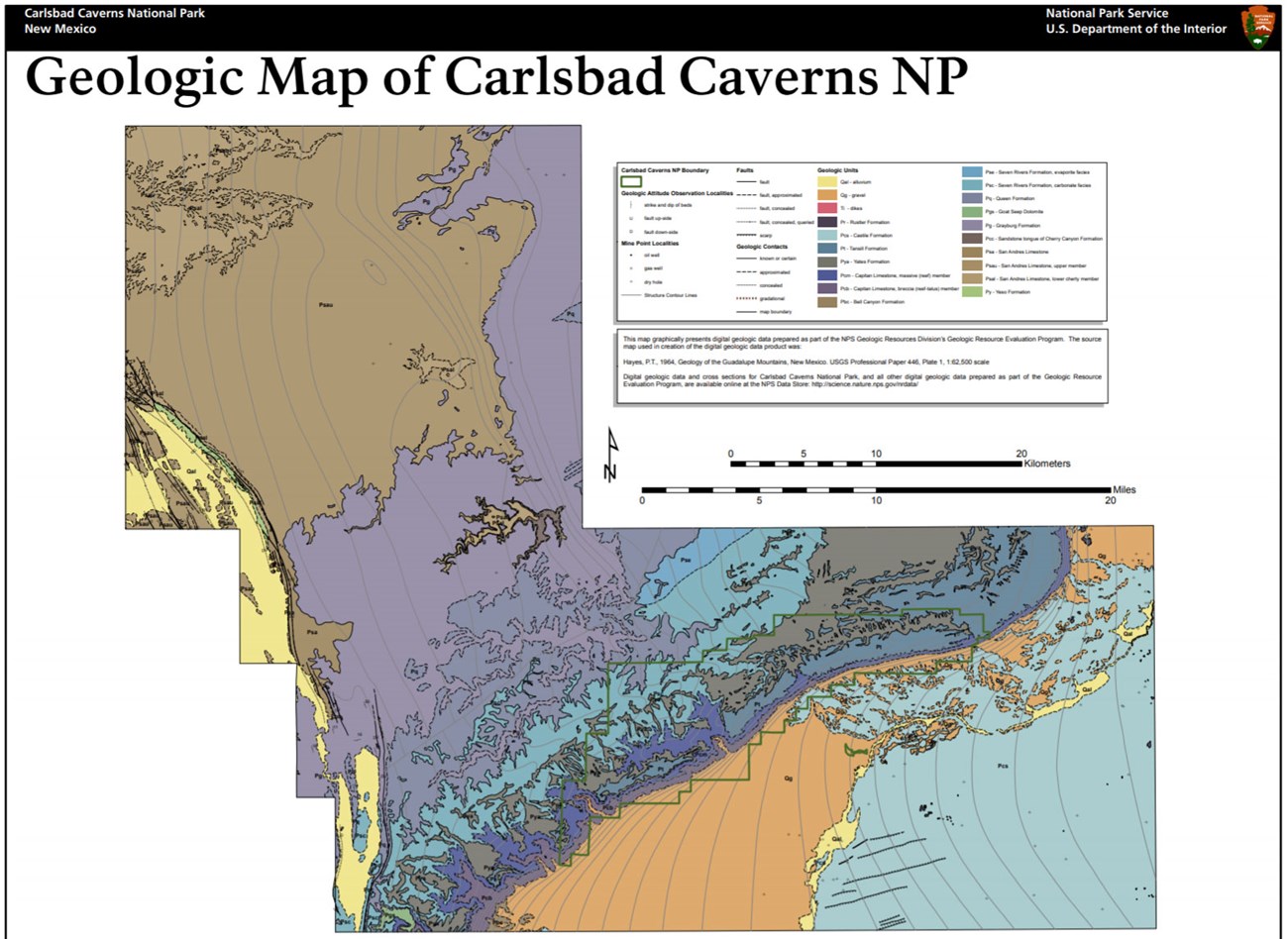Last updated: June 14, 2024
Article
NPS Geodiversity Atlas—Carlsbad Caverns National Park, New Mexico
Geodiversity refers to the full variety of natural geologic (rocks, minerals, sediments, fossils, landforms, and physical processes) and soil resources and processes that occur in the park. A product of the Geologic Resources Inventory, the NPS Geodiversity Atlas delivers information in support of education, Geoconservation, and integrated management of living (biotic) and non-living (abiotic) components of the ecosystem.

Geologic Features and Processes
The Guadalupe, Apache, and Glass Mountains are remnants of an extensive Permian reef complex that developed 260 to 270 million years ago. The principal reef, Capitan Reef, is exposed both above and below the surface at CAVE in the Upper Permian Capitan Limestone (Santucci et al. 2007). The reef reaches a thickness of 1,800 feet and extends for hundreds of miles. The enormous barrier reef is different from modern reefs, in that, the reef framework is composed of sponges, algae and bryozoans (Graham 2007).
Cave and Karst
Carlsbad Caverns National Park is one of the world's greatest cave and karst parks. Permian-aged reef complex is composed of dolomite and limestone and holds two of the world's most spectacular and longest caves, Carlsbad Cavern and Lechuguilla Cave.
At more than 30 miles in length, Carlsbad Cavern contains heavily decorated large passages and rooms and contains the Big Room, the largest easily accessible cave room in the United States. At over 138 miles in length, Lechuguilla Cave is the 7th longest cave in the world and is the deepest limestone cave in the United States at 1,604 feet deep. Lechuguilla Cave contains unique minerals and speleothems such as the large gypsum "chandeliers" that hang from ceilings in one room that are 20 feet in length and weigh hundreds of pounds.
Carlsbad Caverns National Park was designated a World Heritage Site in 1995 because of this superlative geologic setting of the Capitan Reef Complex and its magnificent caves. The reef complex contains a large fresh water aquifer, the Capitan Aquifer, that supplies water to the town of Carlsbad and some of the surrounding communities.
The hypogenic sulfuric acid process of cave dissolution was first described from caves of the park and area. In essence, hydrogen sulfide from oil and gas deposits beneath the park traveled upward through factures into the Capitan aquifer creating a mild sulfuric acid solution that formed the large cave systems we find today in the park and the Guadalupe Mountains.
Native Americans first traveled into the area 11,000 years ago utilizing caves as shelter and water sources. The entrance to Carlsbad Cavern was a very sacred place, possibly due to the large bat flights of Brazilian free-tailed bats that leave the cave every evening in the warm months of the year. At least sixteen other bat species live in or travel through the park, many of them utilizing caves as well. Other animals use caves of the park as well including the largest and most northern colony of cave swallows, a number of vertebrates such as mountain lions and ringtails, as well as numerous invertebrates, many unique to the park and the area. Of interest, hundreds of unique strains of microbes have been cultured from within caves of the park, some exhibit potential for medicinal values.
All NPS cave resources are protected under the the Federal Cave Resources Protection Act of 1988 (FCRPA)(16 U.S.C. § 4301 et seq.).
Paleontological Resources
A rich assemblage of marine invertebrate fossils has been found in the park including fusulinids, brachipods, scaphopods, cephalopods, and crinoids (Santucci et al. 2007). Other fossil fauna found at CAVE include two species of trilobite and the largest fossil sponge yet known from the Permian (Santucci et al. 2007).
Thirty-six species of vertebrate fossils have been identified from Carlsbad Caverns, Musk Ox Cave, Lechuguilla Cave, and Slaughter Canyon Cave. Inside Musk Ox Cave an extensive Late Pleistocene vertebrate fauna was discovered and excavated from the 1950's to the 1970's. The assemblage of vertebrate fauna died after being trapped in a large sinkhole (Santucci et al. 2001). An 85% complete skeleton of a Pleistocene "shrub oxen" was found in 1975 by James Goodbar which initiated additional explorations in the cave for more fossil remains. The paleontological remains indentified through further fossil collecting by paleontologists from Texas Tech University and the Smithsonian Institution included an Equus, artiodactyl, Bassariscus, Spilogale, Neotoma, a dire wolf, and a bobcat-like cat.
All NPS fossil resources are protected under the Paleontological Resources Preservation Act of 2009 (Public Law 111-11, Title VI, Subtitle D; 16 U.S.C. §§ 470aaa - 470aaa-11).
Regional Geology
Carlsbad Caverns is near the edge of the Great Plains Physiographic Province and shares its geologic history and some characteristic geologic formations with a region that extends well beyond park boundaries.
- Scoping summaries are records of scoping meetings where NPS staff and local geologists determined the park’s geologic mapping plan and what content should be included in the report.
- Digital geologic maps include files for viewing in GIS software, a guide to using the data, and a document with ancillary map information. Newer products also include data viewable in Google Earth and online map services.
- Reports use the maps to discuss the park’s setting and significance, notable geologic features and processes, geologic resource management issues, and geologic history.
- Posters are a static view of the GIS data in PDF format. Newer posters include aerial imagery or shaded relief and other park information. They are also included with the reports.
- Projects list basic information about the program and all products available for a park.
Source: NPS DataStore Saved Search 2769. To search for additional information, visit the NPS DataStore.
A NPS Soil Resources Inventory project has been completed for Carlsbad Caverns National Park and can be found on the NPS Data Store.
Source: NPS DataStore Saved Search 2751. To search for additional information, visit the NPS DataStore.

Related Links

